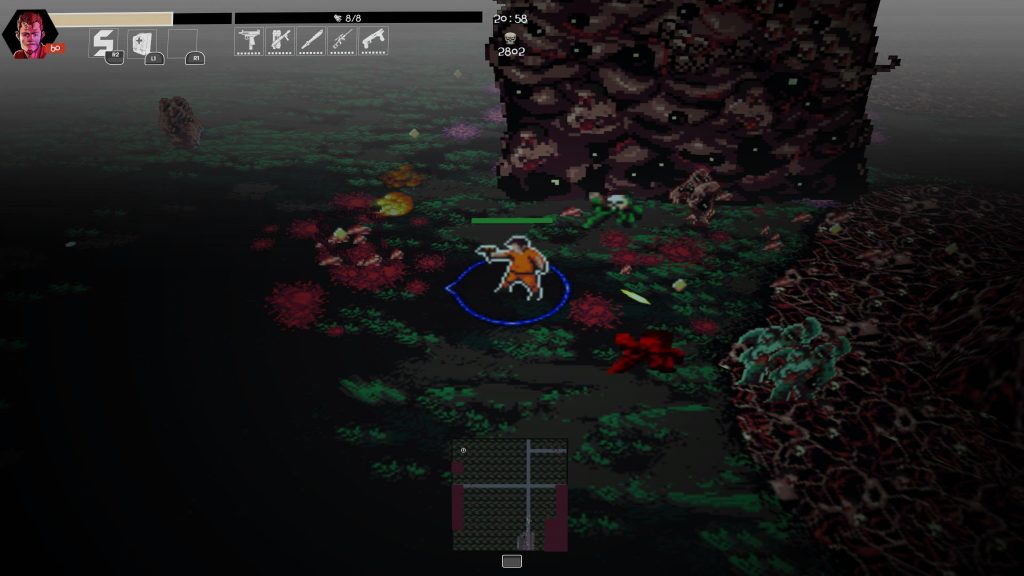Outer Terror is an auto-shooter from Virginia-based studio Salt & Pixel LLC (actually solo developer Brandon Rodriguez) that follows the current trend of filling PSN with Vampire Survivors clones, something we don’t mind as we’re constantly banging on about the greatness of that game and Brotato. This one is quite different though. While you’ve still got the key elements – auto-shooting and perk upgrade choices when you level up – this game adds a whole host of elements that you just don’t normally see in the genre.
The game opens with a choice of five story missions, each with different settings, enemies and backstories, and you also get to choose from tenplayable characters. The only real differences between these characters are their main sprite design and their starting weapon though.
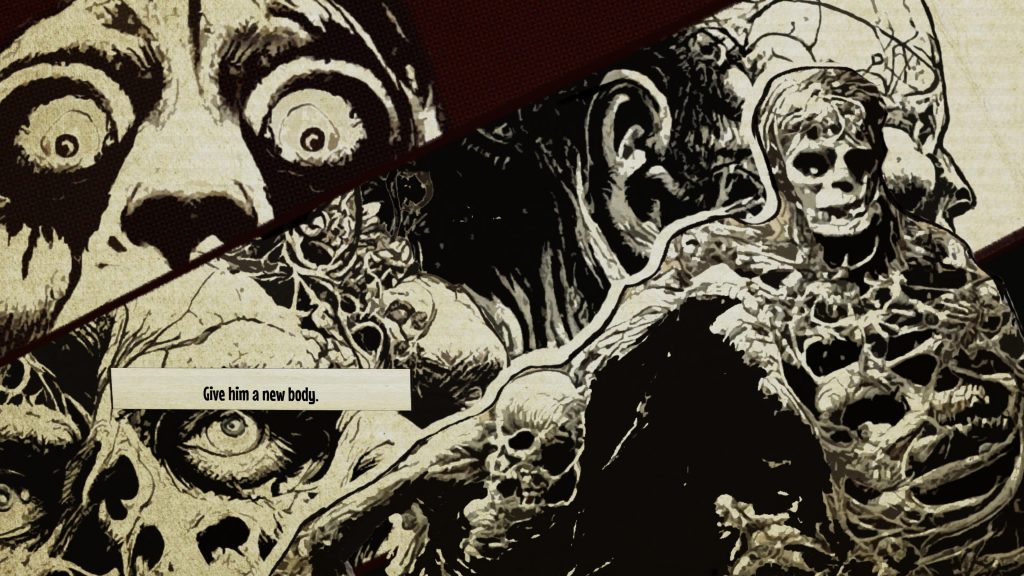 We started out with the default story ‘Gray Death’ but each story begins with a comic book style introduction before throwing you into the action. The art style for these is pretty great by the way. This first story one sees you starting off on grassland with no indication of what to do next. We headed South though and that brought us to a road, at which point the game told us to head down to an indicator (something other levels don’t do) where we met a Professor who then gave us our next task. Yes, Outer Terror actually has a mission-based structure and that’s pretty interesting for a genre that is usually just based on blasting hordes.
We started out with the default story ‘Gray Death’ but each story begins with a comic book style introduction before throwing you into the action. The art style for these is pretty great by the way. This first story one sees you starting off on grassland with no indication of what to do next. We headed South though and that brought us to a road, at which point the game told us to head down to an indicator (something other levels don’t do) where we met a Professor who then gave us our next task. Yes, Outer Terror actually has a mission-based structure and that’s pretty interesting for a genre that is usually just based on blasting hordes.
But, as we said, this is an auto-shooter. So the main thing you need to know is that you’ll be walking around with the left stick and your character will shoot anything that gets close. You can force this too by simply pushing the right stick to aim in a specific direction but this was pretty inconsistent with us sometimes shooting and sometimes not. When it works though, it’s nice to have the option to force the direction of fire.
The actual core shooting gameplay is alright but not as good as the games that inspired it. There’s talk of this game having ‘bullet hell’ elements but that’s not accurate at all as the enemies don’t shoot and so mainly it’s just a load of poorly-defined horror-themed enemies heading towards you in large but not excitingly large numbers. After the hordes of Vampire Survivors and Brotato, this is all a bit underwhelming and your firepower is never dynamic enough to feel like you’re blazing through them, nor particularly impactful. This is one of those games where you always feel a little underpowered.
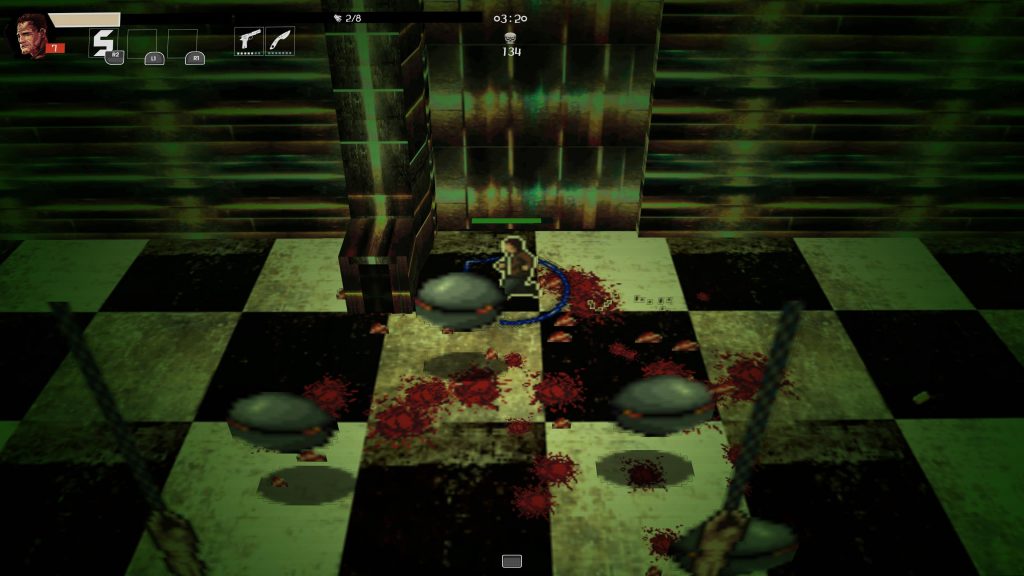 Each time you level up, you’ll be given a choice of weapons to equip (or upgrade if already equipped). These are really just your usual knives and guns, nothing particularly innovative or exciting. So while you might have five or six weapons on the go, it’s not like you really notice or feel them. That is, of course, not the case in the better games in this genre and it’s a bit disappointing to equip a new weapon and then not really feel the benefit.
Each time you level up, you’ll be given a choice of weapons to equip (or upgrade if already equipped). These are really just your usual knives and guns, nothing particularly innovative or exciting. So while you might have five or six weapons on the go, it’s not like you really notice or feel them. That is, of course, not the case in the better games in this genre and it’s a bit disappointing to equip a new weapon and then not really feel the benefit.
Anyway, after meeting that Professor, he sent us off to go and investigate a shack and then after that we weren’t sure what to do next. We found a few side missions that all start in the area the Professor is in but beyond that the level was big and fairly sparse. But then, exactly twenty minutes in, the boss shows up (a sort of demonic flesh wall). Beat him and you’ve beaten the level. Given how arbitrary the boss’ arrival is at that time, it’s odd that the game doesn’t just tell you to hold out until then. But the game never really tells you any key information and that’s a problem going forward.
The other levels have interesting ideas, one is set in a lab that seems to go into a mansion, another sees you being harassed by rogue toasters and TVs in a battle against AI and one sees you battling the elements but each level also its issues, with them all invariably dropping the ball at some point.
For example, there’s Otherside which is just the strangest thing. You’re tasked with rescuing your sister and to do this you need to go from area to area looking for an obelisk each time. There are some issues here though. This story uses the two worst types of level design – mazes and ‘needle in a haystack’ empty spaces. You walk around a desert type area until you find the obelisk and then you walk around a maze area doing the same. You flip between the two types a bunch of times.
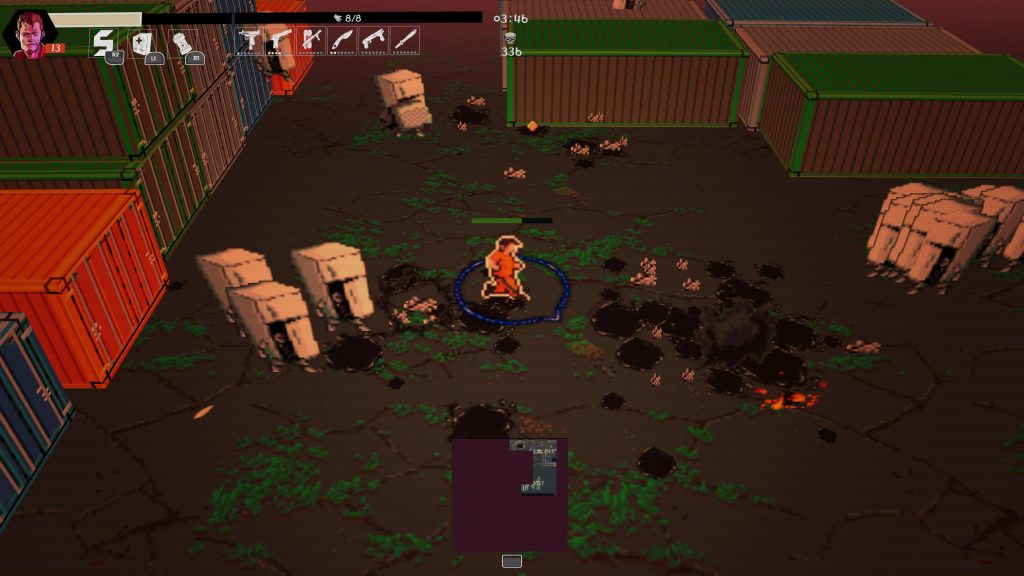 Firstly, it’s just not intuitive. Going back and forth feels like you’re making no progress and given that looted items stay on the floor in each area, you don’t feel like you’re progressing but just going one step forward and one step back. The main issue though was that in one maze area the obelisk simply didn’t appear. Trust us, we spent thirty minutes going around that area trying to find it and we knew the layout completely by the end. It had either bugged out or the obelisk had spawned inside a wall or something. Frustrating. We restarted it and eventually finished the mission though.
Firstly, it’s just not intuitive. Going back and forth feels like you’re making no progress and given that looted items stay on the floor in each area, you don’t feel like you’re progressing but just going one step forward and one step back. The main issue though was that in one maze area the obelisk simply didn’t appear. Trust us, we spent thirty minutes going around that area trying to find it and we knew the layout completely by the end. It had either bugged out or the obelisk had spawned inside a wall or something. Frustrating. We restarted it and eventually finished the mission though.
The AI level, Killswitch, gives you absolutely no clues as to what to do but eventually, thanks to a series of videos from the publisher (of which there are eight and most of them concentrate on telling you things you won’t struggle to figure out while ignoring all the stuff you need to know until the last video), we learned that we had to find a safe house area which then led us to an EMP device which we then had to take back to the safe house area in order to take out a giant robot boss that we’d previously tried fighting for ten minutes because the game just doesn’t give you any feedback or guidance at all.
There’s a level set in the snow had us pretty baffled too. Given that each level is essentially a large square, walking around them trying to find fuel while slowly freezing to death isn’t what we’d call fun. Especially with you constantly having to fend off a dozen or more enemies as you do it.
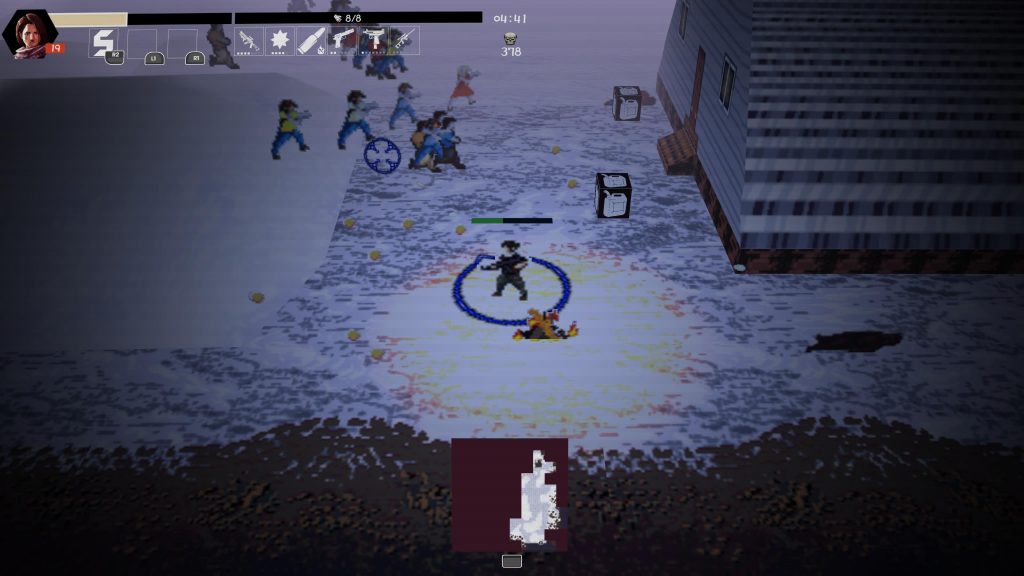 Even if the level design was better, the overall look and feel of the game needs work too. While we like the scene setting from the comic panels, the in-game presentation is pretty poor and doesn’t really sell the scenarios the comics set up. Rather than the usual top-down view that these games tend to adopt, this game goes for a forced perspective using PS1-style low-poly 3D. It all looks a lot like the old game Loaded from 1995 if you remember that. But it also looks a lot worse. The textures here are never not ugly, the character and enemy sprites look like they were made on a Commodore 64 and the zoomed in to look even worse and in levels with any kind of objects in them, you often have your view entirely obscured. Indeed, when you’re being chased by the big robot that we mentioned before, if he gets South of you, you can’t see anything. Oh and enemies in that level can just walk through massive cargo containers because collision detection and pathfinding is difficult apparently.
Even if the level design was better, the overall look and feel of the game needs work too. While we like the scene setting from the comic panels, the in-game presentation is pretty poor and doesn’t really sell the scenarios the comics set up. Rather than the usual top-down view that these games tend to adopt, this game goes for a forced perspective using PS1-style low-poly 3D. It all looks a lot like the old game Loaded from 1995 if you remember that. But it also looks a lot worse. The textures here are never not ugly, the character and enemy sprites look like they were made on a Commodore 64 and the zoomed in to look even worse and in levels with any kind of objects in them, you often have your view entirely obscured. Indeed, when you’re being chased by the big robot that we mentioned before, if he gets South of you, you can’t see anything. Oh and enemies in that level can just walk through massive cargo containers because collision detection and pathfinding is difficult apparently.
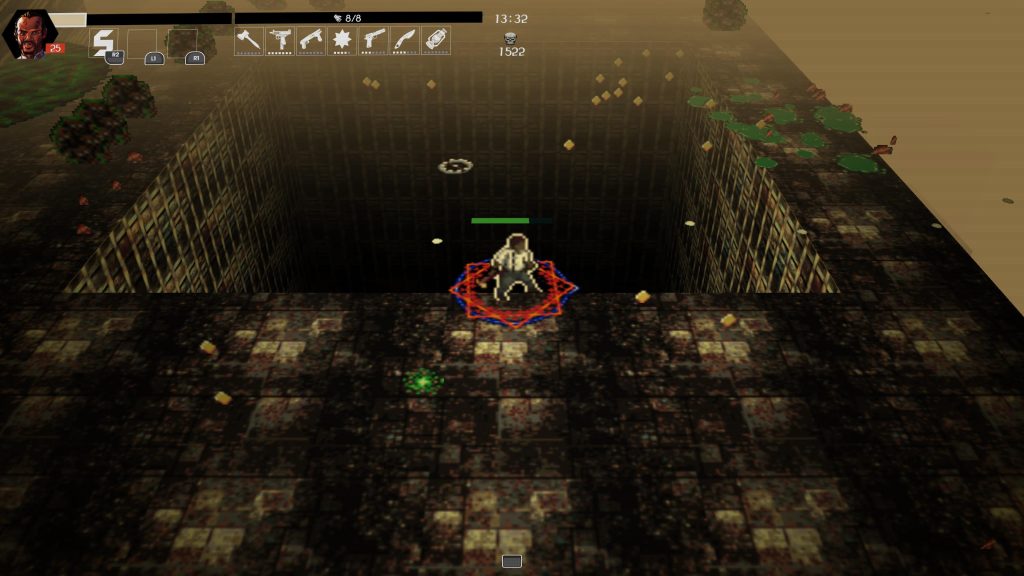 But there’s also a real lack of polish to things here. Some of the issues are minor, such as various spelling mistakes in the story and in menus. Stuff that should have been spotted in playtesting. But there were others, such as way that our character constantly sounded like they were being hurt in Killswitch even though they weren’t, or the way that two levels have these giant black pits in them but yet dead bodies (which are used for looting health and gadgets) and money would often spawn right on top of the holes.
But there’s also a real lack of polish to things here. Some of the issues are minor, such as various spelling mistakes in the story and in menus. Stuff that should have been spotted in playtesting. But there were others, such as way that our character constantly sounded like they were being hurt in Killswitch even though they weren’t, or the way that two levels have these giant black pits in them but yet dead bodies (which are used for looting health and gadgets) and money would often spawn right on top of the holes.
The reason why Vampire Survivors and Brotato worked though wasn’t because of presentation, it was down to the balance and the upgrades and that’s where these inferior clones struggle. It’s the gameplay. And while Outer Terror has some moments where it kind of works, nothing is done particularly well. The in-game upgrades feel weak, as we said before, but the permanent upgrades that you access from the main menu are a much bigger issue.
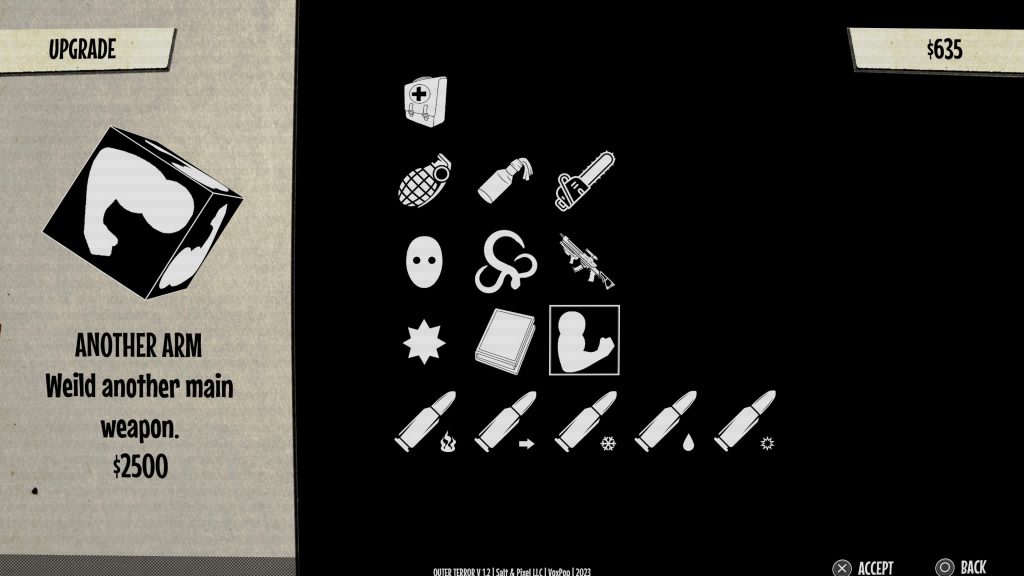 Aside from the name, there’s no real description of what you are buying and that’s an issue because the items are so expensive. You’ll need to play half a dozen missions to afford any of it and none of it is good. For example, you can buy a chainsaw but this ends up being a gadget that lasts less than five seconds and barely helps. The ‘Repel’ gadget is even worse and is just a complete waste of time and inventory space. And none of the upgrades are applied right away, they always take up a space so essentially you’re losing a weapon slot to get their benefit.
Aside from the name, there’s no real description of what you are buying and that’s an issue because the items are so expensive. You’ll need to play half a dozen missions to afford any of it and none of it is good. For example, you can buy a chainsaw but this ends up being a gadget that lasts less than five seconds and barely helps. The ‘Repel’ gadget is even worse and is just a complete waste of time and inventory space. And none of the upgrades are applied right away, they always take up a space so essentially you’re losing a weapon slot to get their benefit.
The only things this game really has going for it is an original take on how to do this genre, some pretty good music and a bit of confidence in its storytelling but when it comes to general presentation, game mechanics and generating addictiveness, it’s very lacking indeed and that’s such a shame because we really want to like Outer Terror. It combines one of our favourite genres with some of our favourite subject matter (we’re huge marks for horror anthology movies) but this feels messy, badly playtested, buggy and it fails the main test for any retro-styled game in that even in 1995 this wouldn’t have been particularly impressive.
+ Adds a few interesting ideas to the formula
+ Reasonably enjoyable occasionally
+ Some good music
- Upgrading feels inconsequential
- Weapons lack impact and identity
- Some terrible level design
- Buggy and poorly tested


